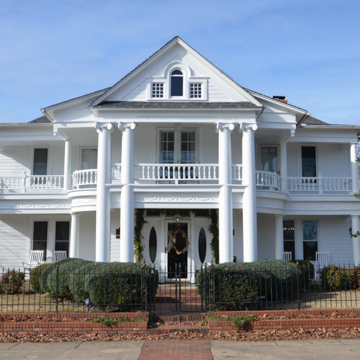You are here
Carriage House Inn
Constructed in the same year that Mena was incorporated, this imposing white frame two-story Colonial Revival structure, one of the grandest of Mena’s nineteenth-century dwellings, represented the energy and optimism not only of young lawyer Benjamin Shaver but also of the citizenry of the bustling young railroad town. Two pedimented pavilions step forward from the house’s hipped roof; the front one, supported by monumental columns with Ionic capitals, has a small Palladian window in its pediment. As a dramatic counterpoint to this vertical porch is a two-story porch upheld by Tuscan columns wrapping around the facade along which flows a graceful balustrade curving at the corners of the projecting units. The wide entablature of the lower porch is ornamented with graceful swags, the curves of which reappear in the prominent oval glass panels of the front door and sidelight.
Dorothy and Elsie Shaver, daughters of Benjamin, created and successfully marketed dolls called “Little Shavers” with the silhouettes and costumes of the modern flapper. Later, Dorothy became the first woman vice president of the Lord and Taylor department store. The house is now a bed-and-breakfast.
Writing Credits
If SAH Archipedia has been useful to you, please consider supporting it.
SAH Archipedia tells the story of the United States through its buildings, landscapes, and cities. This freely available resource empowers the public with authoritative knowledge that deepens their understanding and appreciation of the built environment. But the Society of Architectural Historians, which created SAH Archipedia with University of Virginia Press, needs your support to maintain the high-caliber research, writing, photography, cartography, editing, design, and programming that make SAH Archipedia a trusted online resource available to all who value the history of place, heritage tourism, and learning.


